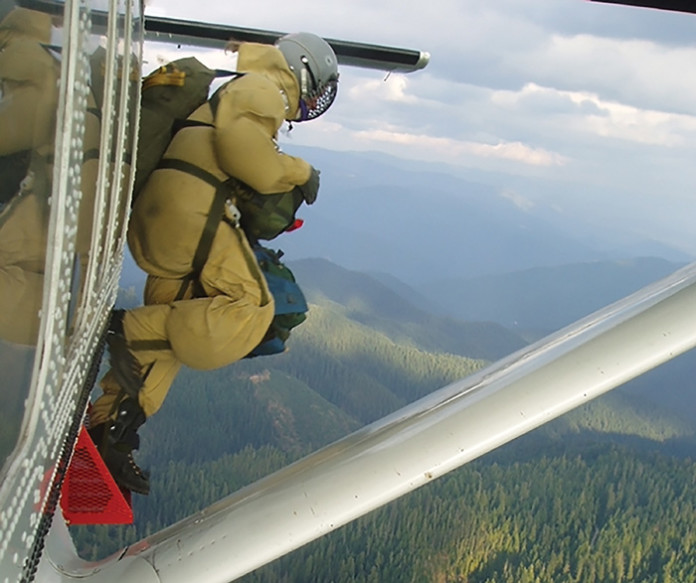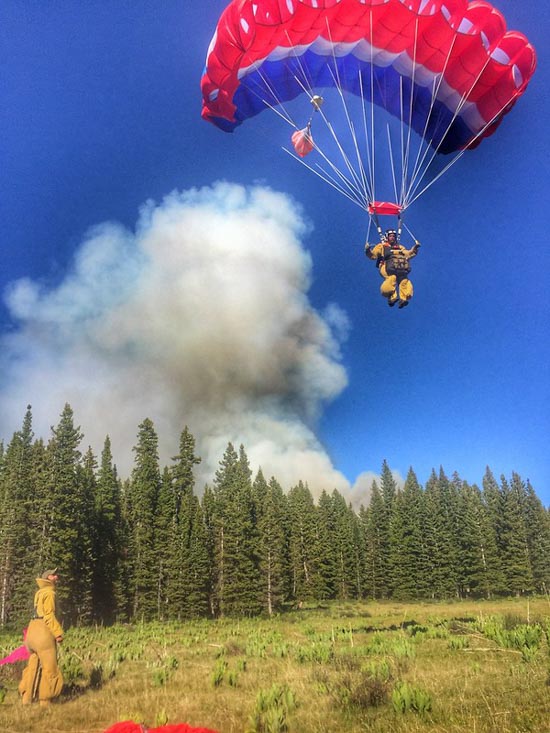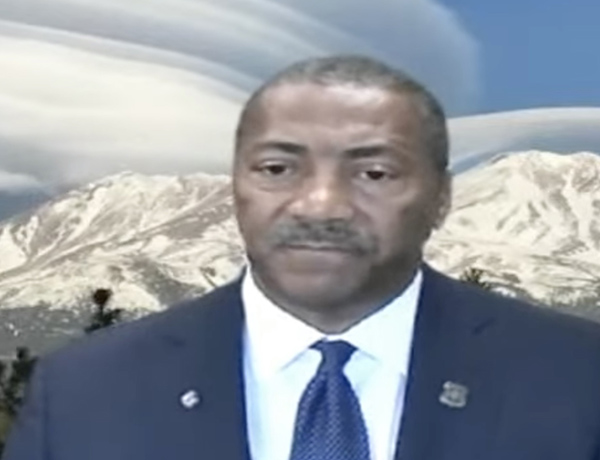
by John Culbertson
Wildland firefighter pay and work conditions are in the national dialog. In the October 2021 issue of SMOKEJUMPER I commented that smokejumpers and hotshots that want better pay and benefits are finding jobs with local agencies. I wondered what those who had recently taken these jobs thought. After talking it over with SMOKEJUMPER Editor Chuck Sheley, we agreed that for the public good a survey should be conducted and the results made available to the public and decision makers in addition to publishing this article in the April, 2022 issue of SMOKEJUMPER.
To remain unbiased I used a fixed set of questions similar to those used in business when interviewing for needs or solutions. The respondents were kept anonymous.
Twenty ex-smokejumpers who worked at U.S. Forest Service or Bureau of Land Management bases were interviewed. Of those, 17 have left the federal government to take jobs with local agencies in Southern California and the Sierra Nevada. Three have transferred to other Forest Service fire management positions. All smokejumper bases were represented, as are all Southern California Counties with significant fire activity.
Eight jumped within the last five years. Seven within the last ten years. The other five jumped within the last twenty years and are in management positions.
It has been a busy fire season and all were working when interviewed. Ninety percent of those interviewed either got a call while we were interviewing, had just returned from a call or were on an overhead assignment. Most interviews involved multiple phone calls, many over multiple days. The persistence, positive attitude and cooperation of the jumpers has been remarkable. What I found has been both encouraging and surprising.
The Smokejumpers averaged six years of crew experience prior to jumping for the Forest Service or BLM. Experience includes Initial Attack crews (2IA or IA), Interagency Hotshot Crews (IHC) and Helitack crews. Prior work with the Forest Service, BLM, NPS, state and local fire agency crews is represented in this survey.
Contact with an ex-jumper, frequently a supervisor or fire manager was part of the path to jumping for almost all.
Over half had taken a decrease in pay, GS grade or resigned an appointment in order to jump in the GS-5 rookie position. Most had been at crew overhead level and had an AA degree, professional certificate or higher. Less than half were veterans.
Years jumped averaged three. There were two distinct groups. About half jumped one or two seasons while the rest jumped three to six seasons with one significantly more.
All spoke highly of their smokejumper experience and prior hand crew experience.
All expressed strong loyalty and hopes for the best for the Forest Service and BLM. Many expressed a patriotic belief in helping to take care of their country. Reference to conservation principles needed for forest management and the history of public lands was brought up by over half the jumpers. There was considerable expression of desire to not leave jumping or the agencies and concern for the future of jumping mixed with frank consideration of their own situation.
Family needs and salary were intertwined as a subject most voiced as the top reason for leaving jumping with all but one respondent who voiced career development as his reason.
Almost all had discussed leaving jumping in detail with a spouse, ex-spouse or significant other. Time away on fire assignment, the need for significant overtime to support a family, desire to purchase a house, a stable location for family and schools, lack of employment opportunity for spouse in jumper towns and the lack of upward movement in the jumper organization or back at a home forest unit were all frequently cited as issues discussed.
Seven hundred and fifty hours of overtime was the average families depended on while jumping. Due to Federal pay structure, this equals about fifteen hundred hours away from home. Time away from family figured into this issue.
Job location was a factor for a spouse or significant other as it related to school choice, professional opportunity and home purchase.
The majority of jumpers brought up professional development. There is little upward movement in the jump organization. Career development, mentoring and interest in fire management were not given enough consideration by supervisors during evaluations and career counseling at the bases.
Using jumping as a pathway to fire management was a desire of many. About half the jumpers expressed a desire to work in a home forest unit in either fire management or on a district ranger path.
Many had hope of a future in the Forest Service, BLM or NPS and were willing to compromise and receive less pay than local agencies to make this happen but were thwarted by the federal hiring system. A typical comment was that they received no replies to inquiry’s regarding positions with Federal Agencies. The centralized federal hiring and personnel management system was frequently mentioned as frustrating to deal with.
An exception to this was jumpers on detail and one who sought out an apprentice program appointment. After leaving jumping, everyone in this group worked towards fire management positions within the Forest Service. This took an average of six years moving between positions and physical locations. These jumpers showed considerable adaptability in taking on a Forest Service career, including postings to the Washington office and international assignments. All had purchased homes and carried that equity with them on assignment.
For those taking local agency fire jobs, most mapped out a course and began a transition while still jumping. This included completion of online college and fire academy classes and contact with potential employers. The average transition time was three years with 60% taking transitional wildland fire or EMS jobs with local fire agencies.
Those taking transitional jobs with local agencies on IA, vegetation management programs (VMP) and EMS crews all took on positions of responsibility such as lead, squad or foreman. This allowed them to be available for interviews, become known locally and complete training classes such as fire academy or EMT classes.
Many local agency fire managers assisted these jumpers in their transition to full time local agency fire jobs even when employment was found at another agency. For many, this filled the mentoring and career planning need they had not found at the jump base.
Full time paramedic training and internship was a considerable undertaking. Three couples lived on the spouse’s earnings while the ex-jumper used savings from jumping to go through a year and a half of classes and internship.
Department of Defense (DOD) fire employment was another avenue of transition. Designation as a firefighter and DOD pay structure provided a living wage for a family without the lengthy overtime requirements cited above for the Forest Service and BLM.
With a few exceptions the local agency fire jobs required the smokejumper to go through the same highly competitive application and testing process with all other applicants. Smokejumping was simply an added plus to meeting the education, academy, EMT, written and physical test requirements. Contact with local agency managers and local wildfire transition jobs also helped.
Adapting to this process was noted as an adjustment by many. In particular, interview skills were something that had to be developed. Once hired as firefighters the smokejumpers, like all recruits, had to meet stringent probationary requirements that included frequent testing and evaluation. Pay structure during probation varied by agency but was greater than that received as a smokejumper. Average age on obtaining local agency probationary status was thirty-three with average interview age of thirty-seven.
On completion of probation the new firefighters starting salary averaged about $80,000 plus significant benefits. The range of starting salary was $68,000 to $92,000. All noted the salary was sufficient to support the family without overtime.
Adjustment to the new job was noted by most. These adjustments were to the call load, witnessing human tragedy, sleeplessness, need to study, commuting and working with people that lacked the camaraderie of crew and smokejumpers the firefighters had worked with in the past. This was not a criticism but an acknowledgment of the reality of living in a fire station. In some cases jumpers considered a return to a natural resource agency job for a simpler life although none did. Discussion with a spouse or significant other was described as part of this process.
All noted the clear-cut mission and service to the public of local agencies.
Some choose to compete for and take wildfire or vegetation management program related jobs within these local agencies. Some aspect of vegetation management programs, prevention, IA crew, dozers and helicopter operations exist with many of the local agencies. After completion of probation some were able to return to their transitional crew in a leadership position. Multiple jumpers noted that local agency VMP and IA crews are both efficient and increasing in number.
All noted the importance of the portal-to-portal pay structure with a huge factor being fewer hours spent away from home and simplicity of paperwork. Local agency overtime is compensated on a portal-to-portal basis, be it for shift work, filling in at a station, short term call back to cover draw down or out of town assignment.
While on probation all were used for out of town wildfire assignments with engine strike teams. All were able to use their qualifications for overhead assignments on completion of probation and most interviewed had been on multiple extended attack and large fires this season as overhead or had occupied back fill positions at the station for the wildfire draw down.
Looking back at their smokejumper jobs, all felt improvement in pay was in order and this extended to their thoughts about crews in general. Inconsistency of jumper use for Initial Attack between bases and agencies was noted by most. “Sitting on the ramp at PL5 (Highest national fire preparedness level),” was a repeated phrase. This extended to winter work for those on some form of permanent status, “Sewing canteen covers (in the winter) is not meaningful work.”
All wanted the best for Federal wildland firefighters and many felt re-classification to firefighter from forestry tech was important. Parity with state wildland agency pay was frequently mentioned as was looking at other Federal fire models such as DOD.
Flexibility in use of employment status and under utilization of existing appointments was mentioned by more than half the jumpers. This related to both the need to retain jumpers that had other things to do during the winter such as ski patrolman as well as the needs of those that wanted permanent jobs and the importance of mentoring those that desired a return to the districts with fire management and district ranger tracks in mind.
Jumpers that had advanced to management roles including those that returned to the Forest Service were particularly concerned with the potential use of solutions already available. Making incremental but meaningful change kept coming up. Retention of GS grade (or equivalent) and appointment status when training as a jumper was considered important. Second year (GS-6) jumpers automatically receiving a 13 and 13 appointment (if they did not already come on board with one) and starting to accrue retirement and access to the TSP (Thrift savings) program were frequently mentioned as possible solutions. All those now in management roles felt there was a strong need for local hiring and administration of personnel matters at the Forest, District and Program level. This included local administration of injured firefighters.
Frustration was frequently voiced over the encouragement of and even counseling jumpers on how to sign up for unemployment. Jumpers wondered why that money was being wasted by the agencies on unemployment when so much could be done with the money by simply running programs that further employment and well being of crews.
A repeated phrase in the interviews was that those that stay with jumping in the Forest Service feel stuck and not valued.
What stood out to me on completion of these interviews was that these jumpers represent skilled, experienced and motivated of people with high agency loyalty and an outstanding positive outlook. If I were seeking people to manage our National Forests and public lands, or any fire agency, I could not find better candidates.
Any loss to the agencies in training dollars and administrative costs when jumpers leave for other fire jobs is small in comparison to the loss of talent and initiative.
It is my opinion that the Forest Service and BLM are dealing with career-focused employee’s (in this case) and yet not providing a professional career environment for them to work in. Pay is one of several significant factors.
One could take a blunt view and say the Forest Service took a simple job and made it complicated with no net gain in efficiency. Something seems wrong. And I think there is some truth to this as it relates to the work force and agency needs. I was left wondering what the Forest Service mission for jumpers is.
My more pragmatic view is that with the exception of pay and a cumbersome personnel management system, things are OK. Smart people within the Forest Service and BLM including the jumpers, Interagency Hotshot Crew overhead, and fire managers at the district and forest level, are working to make things better. The Forest Service and BLM continue to attract talented motivated individuals that receive excellent training and experience and then go out into the world of fire and enrich many agencies efforts in this most important work. For this the Forest Service and BLM should be proud.
* I want to note that in the process of tracking down jumpers I talked with a number of IHC and IA overhead as well as fire managers from many agencies. Many expressed similar concerns and made thoughtful comments. I feel surveys of these highly skilled and experienced people would be meaningful to any agency seeking improvement. There are many solutions and great strength in the diversity of thought I encountered.
This article is scheduled for the April, 2022 edition of Smokejumper magazine. It is published here with the permission of author John Culbertson and the magazine’s Managing Editor, Chuck Sheley.






